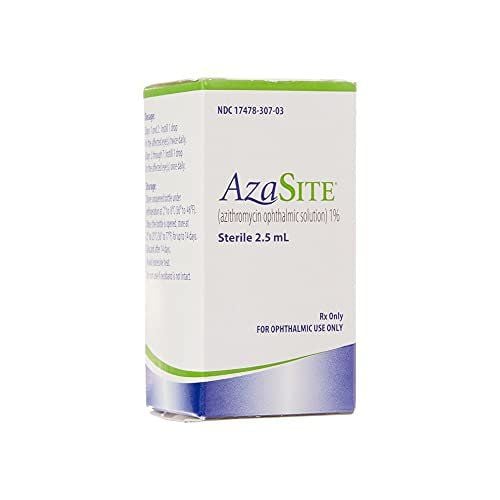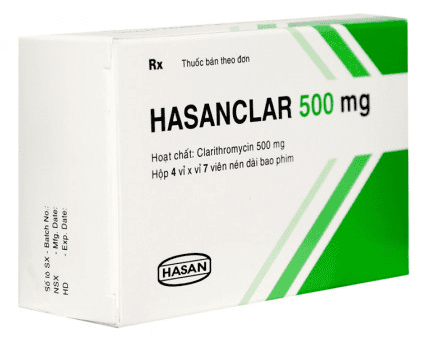This is an automatically translated article.
Zibac is a drug containing the active ingredient Azithromycin, a broad-spectrum antibiotic of the macrolide family that is widely used with strong bactericidal effects. Find out information about ingredients, uses, help patients can use the drug effectively.1. Pharmacology of the drug Zibac (Azithromycin)
1.1. Pharmacokinetics Azithromycin is a semi-synthetic antibiotic belonging to the azalide subgroup of macrolides. The structure of Azithromycin differs from that of Erythromycin - an antibiotic in the macrolide family in the presence of a nitrogen atom replacing the methyl group attached to the lactone ring. Zibac has a strong bactericidal effect by binding to the ribosomes of bacteria, preventing them from synthesizing proteins. Azithromycin is a broad-spectrum antibiotic that is active against both gram-positive and gram-negative bacteria. Azithromycin is effective against some gram-positive bacteria such as Streptococcus (streptococcal), Staphylococcus aureus (Staphylococcus aureus), Pneumococcus (pneumococcal). In addition, some bacterial strains such as Corynebacterium diphtheriae, Peptostreptococcus, Clostridium perfringens and Propionibacterium acnes are also sensitive to Azithromycin. Vietnam has a macrolide resistance rate of up to 40%, which more or less limits the ability to use Azithromycin and bacteria resistant to Erythromycin can also cross-resistant with Azithromycin.
Azithromycin has the advantage in the treatment of gram-negative infections. The gram-negative bacteria sensitive to Azithromycin include Haemophilus influenza, Moraxella catarrrhalis, Acinetobacter,... In general, the effect of Azithromycin on gram-negative bacteria is stronger than that of Erythromycin, while the effect of Azithromycin is slightly weaker on with gram-positive bacteria when compared with erythromycin.
1.2. Pharmacokinetics Absorption: Azithromycin is rapidly absorbed, reaching concentrations in tissues 50 times higher than in plasma. Therefore, Azithromycin has a good effect in the treatment of intracellular bacteria. Distribution: The drug is widely distributed in the body, mainly reaching tissues such as lung, amygdale, granulocytes, prostate macrophages. However, the drug rarely crosses the central nervous system. Metabolism: A small amount of Azithromycin is demethylated in the liver, excreted in the bile unchanged, partly as unchanged drug. Elimination: The drug is eliminated in the urine.
2. Indications for treatment of Zibac
Zibac is indicated for the treatment of the following cases:
Respiratory tract infections. Inflammation of the middle ear. Skin and soft tissue infections. Uncomplicated genital Chlamydia infection. Urethritis not due to gonorrhea. Mild or moderate typhoid caused by multi-resistant bacteria. Prophylaxis of endocarditis in children.
3. How to use, dosage of Zibac
3.1. How to use Zibac drug in the form of powder for suspension, used by intravenous infusion. Dilute the drug into an isotonic solution and infuse slowly at a concentration of 1 mg/ml over 3 hours, 2 mg/ml over 1 hour. In addition, Zibac Tablet is available in the form of film-coated tablets to be taken orally.
3.2. Dosage Dosage given by the manufacturer of the drug Zibac is as follows:
Dose 500 mg x 1 time / day x 3 days;
Children over 6 months: 10 mg/kg x 1 time/day x 3 days; or by weight:
Weight 15-25 kg: dose 200 mg x 1 time/day x 3 days Weight 26-35 kg: dose 300 mg x 1 time/day x 3 days Weight 36-45 kg: 400 mg once a day for 3 days. Uncomplicated genital Chlamydia infections, non-gonococcal urethritis: a single dose of 1 g.
Typhoid: 500 mg x 1 time / day for 7 days.
4. Contraindications to the use of Zibac
Zibac is contraindicated in patients with hypersensitivity to Azithromycin, Erythromycin or other antibiotics of the macrolide family.
5. Side effects of Zibac
Azithromycin is well tolerated with a low rate of side effects. The majority of adverse events observed were mild to moderate in severity, most commonly gastrointestinal side effects such as diarrhea, abdominal pain, nausea, vomiting, and flatulence. Azithromycin may occasionally be associated with an increase in liver transaminases, however this is a reversible increase. Allergic reactions have also been reported with symptoms ranging from mild to severe such as angioedema, anaphylaxis.
6. Zibac drug interactions
Drug interactions of Zibac that may occur during use are as follows:
Azithromycin should be taken at least 1-2 hours before taking antacids. Ergotamine and derivatives: Concomitant use of Azithromycin with ergot-containing alkaloids should be avoided, because of possible side effects. Digoxin and Cyclosporine: Macrolide increases blood levels of Digoxin and Cyclosporine. Therefore, if concomitant use is required, caution should be exercised and serum concentrations of Digoxin and Cyclosporine should be checked.
7. Be careful when using Zibac
Use Zibac with caution in the following cases:
Rare serious allergic reactions, including angioedema and anaphylaxis, have been reported in some cases with Azithromycin. The use of Azithromycin should be done with caution in patients with severe liver disease. Azithromycin should be used with caution in patients with a predisposition to prolong the QT interval on the electrocardiogram, or in patients who are taking drugs with a risk of QT prolongation. In theory, concomitant use of Azithromycin and ergot derivatives is not recommended. Pregnancy/breastfeeding: Safety for use in pregnant or lactating women has not been established. Azithromycin should be used in pregnant or nursing women only when suitable alternatives are not available. In case of drug overdose: Undesirable effects may appear.
8. Storing Zibac
Zibac medicine is stored at a temperature of 15 degrees C to 30 degrees C in a dry place, protected from light. Keep medicine out of reach of children. Zibac is a drug containing the active ingredient Azithromycin, a broad-spectrum antibiotic of the macrolide family that is widely used with strong bactericidal effects. To ensure effective treatment and avoid unwanted side effects, patients need to strictly follow the instructions of the doctor and medical staff.
Follow Vinmec International General Hospital website to get more health, nutrition and beauty information to protect the health of yourself and your loved ones in your family.













